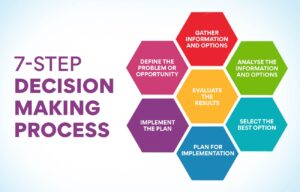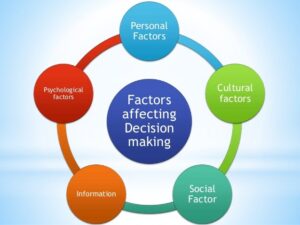Back to: Pre Vocational Studies JSS 2
Welcome to class!
In our previous lesson, we learned about the concept of family resources. Today, we’re going to look deeper into the important topic of decision making. Decision making is a fundamental skill that we use every day, from small choices to major life decisions. Understanding the meaning and steps involved in decision making can help us make informed and effective choices.
Meaning and Steps in Decision Making
What is Decision Making?

Decision making is the process of choosing a course of action from among several alternatives. It involves evaluating different options, considering the potential consequences, and selecting the best course of action based on our goals and values. Decision making is a complex process that involves both rational and emotional factors.
Steps in Decision Making

The decision-making process can be broken down into several key steps:
- Identify the Problem: Clearly define the problem or decision that needs to be made. This involves gathering information and understanding the context.
- Gather Information: Collect relevant information and data that will help you make an informed decision. This may involve research, consultation with experts, or personal experience.
- Generate Alternatives: Brainstorm a list of possible solutions or options. Be creative and consider a wide range of possibilities.
- Evaluate Alternatives: Assess the advantages and disadvantages of each alternative. Consider the potential consequences, risks, and benefits of each option.
- Choose the Best Alternative: Select the option that you believe is the most appropriate and effective based on your evaluation.
- Implement the Decision: Take action to put your chosen solution into effect.
- Evaluate the Outcome: Assess the results of your decision and learn from the experience. This will help you improve your decision-making skills in the future.
Decision-Making Styles

There are different decision-making styles, each with its own strengths and weaknesses:
- Rational Decision Making: This involves making decisions based on logic, reason, and analysis. Rational decision makers carefully weigh the pros and cons of each option and choose the one that is most likely to achieve their goals. This style is particularly effective when dealing with complex problems that require careful consideration and analysis.
- Intuitive Decision Making: This involves relying on intuition and gut feelings to make decisions. Intuitive decision makers may have a strong sense of what is right or wrong, even without consciously analyzing the options. This style can be useful when there is limited time or information available, or when the decision is highly personal.
- Group Decision Making: This involves making decisions as a group, rather than individually. Group decision making can be beneficial because it can draw on the diverse perspectives and expertise of multiple people. However, it can also be challenging to reach consensus and avoid groupthink.
Factors Influencing Decision Making
Several factors can influence the decision-making process, including:
- Values and Beliefs: Our personal values and beliefs can shape our decision-making. We are more likely to choose options that align with our values and beliefs.
- Emotions: Emotions can play a significant role in decision making. Strong emotions, such as fear, anger, or excitement, can influence our choices.
- Cognitive Biases: Cognitive biases are mental shortcuts that can affect our decision-making. These biases can lead us to make irrational or biased choices.
- Time Constraints: The amount of time we have to make a decision can influence our choices. If we have limited time, we may be more likely to make impulsive or intuitive decisions.
- Social Pressure: Social pressure can influence our decisions, particularly when we are trying to fit in or avoid conflict.
How to Improve Decision Making
To improve your decision-making skills, consider the following tips:
- Practice: The more you practice decision making, the better you will become at it. Take opportunities to make decisions in various areas of your life.
- Seek Feedback: Ask for feedback from others on your decision-making process. This can help you identify areas for improvement.
- Learn from Mistakes: Don’t be afraid to make mistakes. Learn from your mistakes and use them to improve your decision-making skills.
- Consider Different Perspectives: Try to see things from different perspectives to gain a broader understanding of the situation.
- Take Breaks: If you are feeling overwhelmed or stressed, take a break and come back to the decision later.
Summary
Decision making is a complex process that involves many factors. By understanding the steps involved in decision making and considering different decision-making styles, we can make informed and effective choices that align with our goals and values.
Questions
- How can you identify the problem or decision to be made?
- What sources of information can you use to make informed decisions?
- How can you generate creative alternatives for a decision?
- What criteria should you consider when evaluating alternatives?
- How can you implement a decision effectively?
We have come to the end of today’s class. I hope you enjoyed the class!
In the next class, we shall be discussing the Simple perssonal and family decision
In case you require further assistance or have any questions, feel free to ask in the comment section below, and trust us to respond as soon as possible. Well done so far and See you in the next class!
